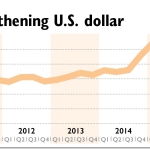In the face of rising costs, the Washington State fruit industry will need to place renewed emphasis on achieving efficiencies throughout its operations for the next few years.

by Desmond O’Rourke, world market analyst and director of Belrose, Inc.,
in Pullman, Washington.
Each new season, apple growers encounter a new throw of the dice on prices. Naturally, most of their attention is focused on prices they receive. However, industry profitability in any season is affected by a number of other prices that are often not called by that name—items such as costs of production, wages, interest rates, exchange rates, and personal living expenses. Fluctuations in these are causing increasing uncertainty about profitability this season, and could affect profitability for years to come.
Price changes not unusual
On present trends, f.o.b. prices for Washington State apples in the 2014-15 season will be about $6 per box below prices in 2013-14. However, as Figure 1 shows, that sort of price change has happened often in the past, for example, between the 1986-87 and 1987-88, 2003-04 and 2004-05, and 2007-08 and 2008-09 seasons.
Figure 1 shows prices rising over time even in lower-price years. However, it fails to take account of steady declines in the purchasing power of the U.S. dollar. Between 1986-87 and 2014-15, the value of the U.S. dollar fell by about half. To keep up with inflation, f.o.b. prices in 2014-15 would have had to be close to $29 per box to equal the purchasing power of a box of apples in 1986-87. So, the expected prices in 2014-15 represent a major reduction in the purchasing power of orchard earnings.
Costs of production
“Cost” is another term used for the prices growers must pay for the inputs needed in production. U.S. Department of Agriculture National Agricultural Statistics Service figures show average costs of production in agriculture rose by 4.7 percent between December 2013 and December 2014 due to small but consistent increases in such items as interest, taxes, wage rates, machinery, and services.
Wage rates in the Washington State fruit industry may rise faster than average in the coming season. The state’s minimum wage remains the highest in the United States and rose by a further 1.6 percent in January 2015. In addition, the effective minimum wage for H-2A workers (the so-called Adverse Effect Wage Rate) has been raised by 4.63 percent to $12.42 per hour. H-2A workers are increasingly used by the Washington State fruit industry to ensure adequate harvest labor. The government-mandated “floor” wages tend to raise wages for all workers.
Oil prices
The major exception to rising costs has been the dramatic plunge in the prices of oil and of oil-based products like diesel, gasoline, and natural gas in the second half of 2014. World market prices for oil fell by more than a half between June and December 2014. In the same period, the average price decline in the United States was about 47 percent for natural gas, 30 percent for gasoline, and 12.5 percent for diesel fuel.
For various reasons, the price of many of the oil-based products used in agriculture change more slowly than world oil prices. For example, the price of fertilizers fell by only 7 percent between June and December 2014, and the prices of agricultural chemicals actually rose by 2 percent. In addition, these materials usually account for less than 20 percent of the variable costs of fruit production, which further reduces their impact on overall production and harvesting costs. That said, a continuation of low world oil prices would provide some cost relief to fruit growers.
Lower oil prices are not entirely beneficial to the fruit industry. While oil is a cost to fruit growers, it is a major revenue source for many major foreign customers. The purchasing power of oil exporting countries has fallen since June 2014. Similar sharp declines in oil prices in the 1980s and 1990s led eventually to much lower purchases of fruit by the major oil-exporting countries like Saudi Arabia and the United Arab Emirates. That is likely to happen again if low oil prices persist.
Another “price” that is having, and will have, a major impact on fruit exports is the exchange rate of the U.S. dollar against the currencies of our major markets and competitors. The exchange rate is just another term for the price one pays for another currency in buying or selling U.S. dollars.
Figure 2 shows the trade-weighted dollar exchange rate—that is, how the value of the U.S. dollar has fared against our major trading partners since 2011.
Figure 2 indicates that products priced in U.S. dollars have, on average, become 23 percent more expensive for our major trading partners since the first quarter of 2011 due to big price spikes in 2011 and in the second half of 2014. This has impeded all U.S. exports. Conversely, products from other countries have become 19 percent cheaper. This will boost their sales in the U.S. market and give them a competitive edge over U.S. products in third-country markets.
Because of numerous troubles in the world economy, the United States has become a refuge for many investors, so the U.S. dollar could continue to strengthen for several more years. In addition, the U.S. government is pushing for higher taxes and the Federal Reserve Board is planning to raise interest rates. •







Leave A Comment